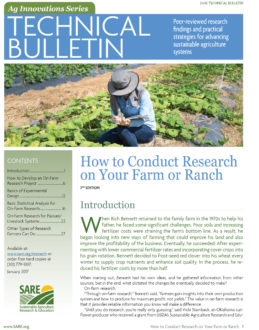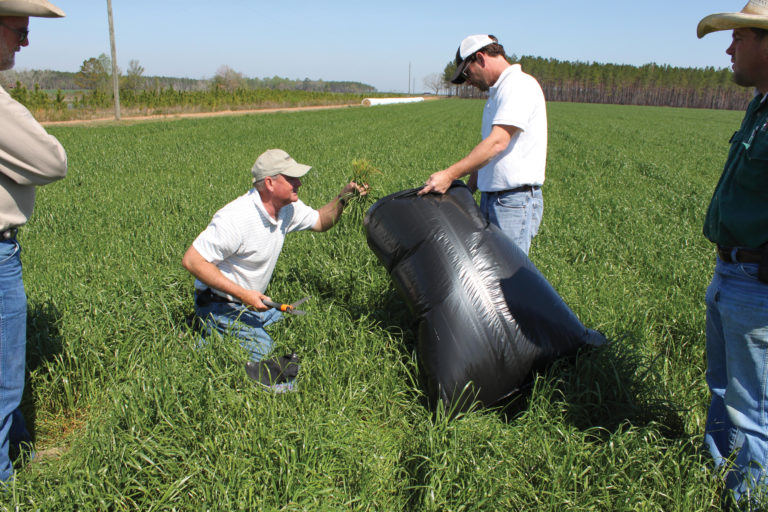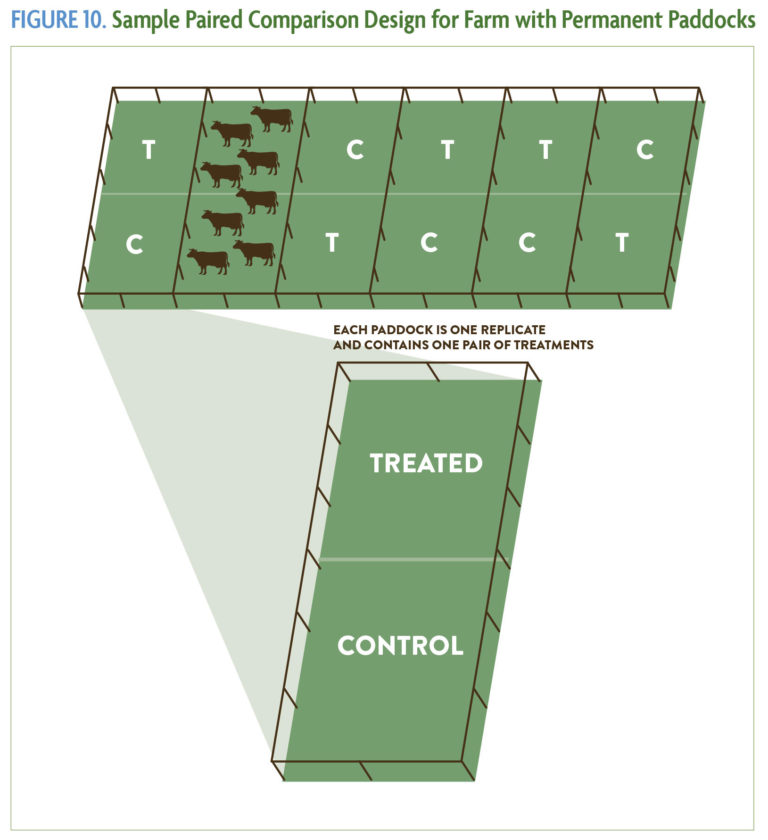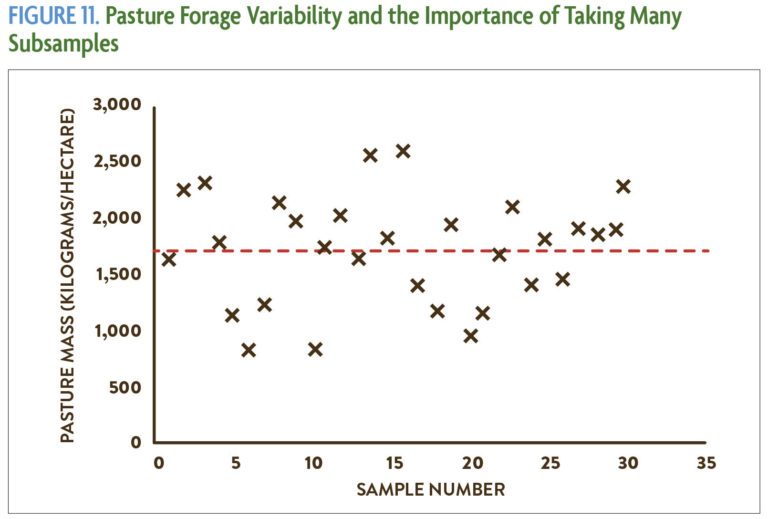Adapted from A Practical Guide to On-Farm Pasture Research. Bridgett Hilshey, Sidney Bosworth, Rachel Gilker. 2013. Published by University of Vermont and Northeast SARE.
On-farm research in livestock and pasture-based systems poses unique challenges compared to crop research. Depending on your research question, you must carefully consider what the experimental unit is for the study. Is it an individual animal? Or is it a group of animals? And how many experimental units will you need?
In either case, it can be difficult to hold management constant across treatment groups, and the livestock themselves add to the amount of variability that could affect the outcomes of the study. In addition, in pasture research you have to account for the diversity of plant species, changes in soil condition and topography, and grazing management variables. Also, as weather conditions change, pasture systems experience daily and seasonal fluctuations in growth rate and forage quality. In most pasture-based research, you cannot use a single measurement (such as yield or growth) at the end of one year to determine treatment effects. To accurately quantify the effect of changes in pasture condition on livestock, you need to know both the productivity and quality of a wide variety of grasses at multiple times throughout the year. As plants and soil within pastures tend to be highly variable, these measurements can be difficult to collect. However, this is commonly addressed by using “repeated measures,” where the same measurement, such as weight gain or milk production, is taken repeatedly on the same animals over the course of the experiment.
Refer to the 10-step process outlined in the previous section, How to Develop an On-Farm Research Project, as your overall guide for developing a pasture-based research project. Also, see the profile of farmer Harry Cope for an example of how one person set up a research project to improve the forage quality of grazed corn by adjusting planting practices and inter-seeding a cover crop mix. In addition, the following suggestions can help ensure your livestock/pasture research gets you the information you need to make the best management decisions:
Formulating your research question. As with crop research, start with a clearly defined research question and objective. The research question should include information on exactly what the treatment will be, what you will measure to determine how effective the treatment is, and other useful details such as the start and end dates of the experiment. Examples of treatments in livestock/pasture projects include a certain fertilizer applied at a certain rate, a new plant species seeded into the pasture or a different feed ration. It is important to include a control group to contrast against the group receiving the experimental treatment.
Selecting the location. When choosing a research site, consider previous crop history (fertilizer rates, herbicides, tillage, etc.), drainage, forage species, soil texture, soil depth, topography, pest infestations and other factors. Choose a field site with the greatest possible uniformity. The goal is to plan and organize the field plot layout to assure that all treatments have an equal opportunity to succeed. For pasture research, you will want a fairly large tract of land, usually enough for at least six paddocks. The study will be easier if you use established, permanent paddocks, even if they are only permanent for the length of the project.
Developing a project timeline. Every research project is different and will require a different timeline. In general, most studies are conducted for at least two years. In pasture studies, you will likely collect data regarding the pasture and/or soil quality at multiple times during the year. That said, it is important to not over commit yourself. Research can be very time consuming—for instance, expect sampling forage quality in 12 experimental units (six paddocks) to take at least 4 hours; collecting soil samples will likely take longer.
Creating experimental units in livestock research. The experimental unit is the physical entity that can be assigned, at random, to a treatment. In livestock studies, it is typically an individual animal. However, any two experimental units must be capable of receiving different treatments. Thus, in a feed study where cows in a pen are given a treatment in the diet, the pen of animals rather than the individual animal is the experimental unit, because the cows in the same pen eat from the same source and cannot be given different diets. If, however, the treatment can be given to individual animals in the pen, such as a medication, then individual animals in the same pen can be used as experimental units.
Creating experimental units in pasture research. If you are conducting the experiment in established paddocks that have set perimeter fences, creating experimental units is relatively easy. You can divide each paddock roughly in half and consider each half to be one experimental unit. Each paddock is one replicate and will contain one pair of treatments (treated and control). You will need six paddocks to complete this experimental design (see Figure 10). If you are conducting the experiment in an area that is strip grazed, setting up the experimental units will require a bit more work. You will be applying the treatments in long narrow strips. Each strip will be one experimental unit. Two adjacent strips will be paired. It is helpful, if you are applying the treatments with a tractor, to make plots that run the length of the field and are one or two tractor passes wide. This makes it easier to apply treatments along the entire strip without having to start or stop in the middle of the field. Decide what width you would like each strip to be; use flags or markers to mark the chosen interval within the field.
Determining experimental design. With livestock studies, animal-to-animal comparisons are used when the treatment being studied can be applied to individual animals (e.g., a mastitis treatment in which the experimental unit is the individual animal). For purposes of experimental design, you might establish a treatment A group, a treatment B group and a control group, with each animal a replication. In studies that use pens or other enclosures as the experimental unit, such as feed studies, you would use several pens of animals to achieve replication. Limiting factors in your ability to do a pen-to-pen study may include your housing or the size of your herd.
The paired comparison design is well-suited to pasture research. By replicating the treatment within every pasture, many factors, such as grazing use, are kept constant. The design is fairly simple to understand and implement; each data pair yields one difference. These differences can be analyzed using the t-test protocol outlined in the statistical analysis section of this publication. In pasture research, the paired comparison is usually characterized by having long strips of treated and untreated (control) land side by side in the field, replicated at least six times. Each pair of strips should be located in an area that is fairly uniform.
TABLE 6. Common Variables in Livestock/Pasture Research
| ANIMAL MEASUREMENTS | SOIL PROPERTIES | FORAGE VARIETIES |
|
|
|
Choosing variables to measure. The kinds of data you collect depend on your research objectives. Some of the common measurements you might collect in livestock and pasture-based research are presented in Table 6.
Specialized equipment and lab analyses are required for some of these measurements, so check with your Extension agent to see where those might be obtained. Be sure that what you are measuring will answer your research question. It is easy to overextend yourself by measuring more variables than you have time or money for. We recommend focusing on two to four variables.
In pasture research, when measuring variables such as soil nutrient content and forage mass, it may be necessary to take many subsamples in order to increase precision. Pastures are “fertilized” and “harvested” by animals; the forage within them is a dynamic, diverse, living community of plants. As a result, the characteristics of the pasture can vary greatly within a small area. To overcome the variability, many samples must be taken in order to accurately estimate what the experimental unit is really like. Usually 30 samples are recommended for an experimental unit a half acre or greater in size. For smaller experimental units, 15 to 20 samples are adequate (see Figure 11). For samples that are shipped to laboratories for analysis, thoroughly mix together at least 20 (or more) samples collected from one experimental unit. Then select a portion of aggregated sample to send out for analysis. Always strive for a good, representative sample.
Analyzing the data. Once you have your data, the statistical analyses are the same as described previously in the section Basic Statistical Analysis for On-Farm Research. If you do get a significant difference between your treatment and your untreated control, what does it really mean? If your treatment yielded 20 percent more pasture mass than the untreated control, will that really result in 20 percent more available pasture for your animals? Using your results, you may now decide to expand your test to a larger pasture area. One approach would be to treat an area that normally (based on past records) gives you about four days’ worth of grazing. Will the treatment now give you five days of grazing in that area?



